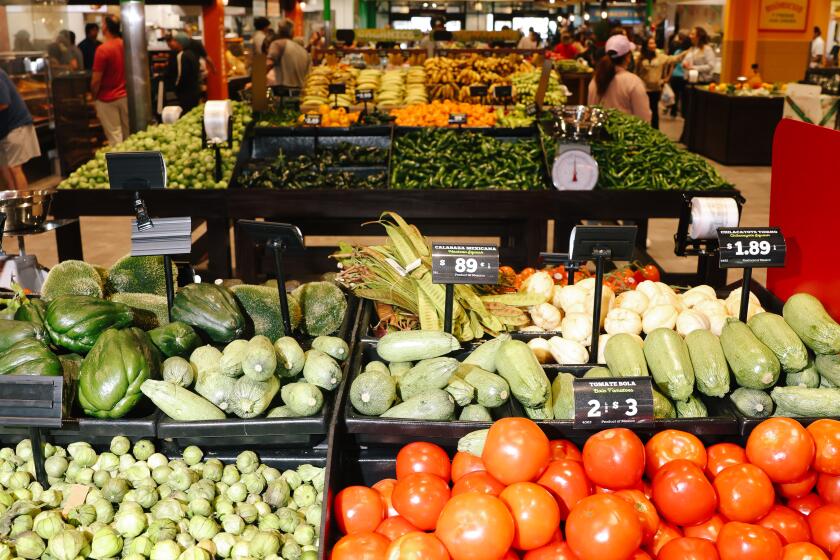Flight of the purple Concords
They’re the Marlon Brando of grapes: intense, explosive and (hey, if we’re talking about the later years) round. Concord grapes -- their dark blue-purple skins give them a brooding quality, their stubborn seeds might amount to difficult behavior. But what makes them a premier talent of American grapes is their rich, distinct, full-bodied flavor. No other grape compares.
Yet for far too long they’ve had “I-coulda-been-a-contender” status at markets. The grape that loaned its trademark jammy flavor to so much soda, juice and jelly has had an uneven career as a table grape. Maybe because their “slip skin” makes them sort of fragile; the skin is thick but isn’t attached to the flesh as with European varieties, so the grapes don’t hold up as well during shipping and storage. And then there are those seeds. . . .
But fresh Concord grapes are so delicious. And they’re available at Southern California farmers markets. Pop one in your mouth, bite into it and the fruit explodes away from the skin. Once you work the seeds out, the sweet grape slides down like an oyster.
And to cook with them is to discover a whole new level of their lusciousness. Alice Waters has an easy grape preparation that works especially well with Concord grapes -- roasting them whole on the vine. Cut them into small, attractive bunches, drizzle them with olive oil and treat them to a 450-degree oven for 10 minutes. The warm, purple-juicy grapes burst through their skins during cooking. Waters doesn’t call for any other seasoning, but if you sprinkle them with a little Maldon sea salt, the crunchy-tender flakes are the perfect complement to the soft, sweet fruit. They’re great with sweet or savory dishes, on top of ice cream or alongside grilled meat.
In fact, Concord grapes are generally fantastic with meat. Made into a wine reduction to sauce seared pork tenderloin medallions, they are reminiscent of fresh cherries. They get meltingly soft cooked in wine, their sweetness mitigated by garlic and shallots. The sauce takes on a deep-purple glazey shine.
At Campanile restaurant, chef-owner Mark Peel makes a deep-flavored, gorgeous granita with Concord grapes, Beaujolais wine, whole cloves and black pepper. It’s gorgeous, with big grape flavor and the kick of pepper and clove.
Peel says you can substitute a Sonoma Pinot Noir for the Beaujolais. Neither should be more than 13% alcohol. Too high an alcohol content can keep the granita from freezing, he cautions.
And Concord grapes are surprisingly suited to a traditional schiacciata Italian flat bread. It’s a focaccia-type bread that’s stretched and shaped by hand before small “dimple-like” indentations are made all over the top of the bread with the fingers. Lightly sugared Concord grapes are sprinkled over the top of the bread before baking.
It’s easy to seed the grapes by pressing the tip of a knife into the stem end of the grape and flicking out the seeds. But it’s not necessary; you can leave the seeds in.
Warm from the oven, the grapes are scented with fennel, rosemary and orange peel. The jammy, luxurious grapes settle into the soft, fragrant bread. Seeds are a small price to pay.
--
donna.deane@latimes.com
--
Concord grape flatbread
Total time: About 1 hour, plus rising time
Servings: 16
Note: From test kitchen director Donna Deane.
2 packages active dry yeast
1 cup warm water (110 to 115 degrees)
3 cups flour, divided, plus additional for kneading
3 tablespoons plus 1 teaspoon olive oil, divided
5 tablespoons sugar, divided
1 1/2 teaspoon fennel seeds, crushed, divided
1 1/2 teaspoons minced rosemary, divided
1/2 teaspoon grated orange zest
1 1/4 teaspoons salt
3 cups Concord grapes (about 1 pound grapes)
1. In a medium bowl, sprinkle the yeast over the warm water and stir to dissolve. Stir in 1 cup of the flour until smooth. Cover and let stand 1 hour.
2. Transfer the yeast mixture into a large mixing bowl and stir in 2 tablespoons of the olive oil, 3 tablespoons of the sugar, one-half teaspoon of the fennel seeds, one-half teaspoon of the rosemary, the orange zest and the salt. With a fork, beat in 1 cup of the flour until blended. Beat in the remaining 1 cup flour. On a lightly floured board, knead the dough for 5 minutes until smooth and satiny.
3. Place the dough into a large bowl lightly coated with 1 teaspoon olive oil and turn to coat all sides of the dough. Cover and let rise in a warm place until doubled, about 1 hour. Punch down the dough and knead lightly for a minute, then pull and shape into a 16-by-9-inch rectangle on a baking sheet.
4. In a small pan, heat 1 teaspoon of the chopped rosemary in the remaining 1 tablespoon olive oil over low heat just until warm. Brush the top of the dough with it. Let the dough rise until puffy and doubled, about 30 minutes.
5. Meanwhile, heat the oven to 375 degrees. Wash the grapes and pat them dry. You can either remove the seeds from the grapes or leave them intact. They can be removed quite easily without cutting the grapes in half: Insert the tip of a small knife into the stem end of the grape and lift out the seed. Toss the grapes with the remaining 2 tablespoons sugar and let stand while the dough is rising.
6. Using your fingers, make random indentations to cover the entire surface of the bread, as with focaccia. Gently press the grapes into the indentations to keep them in place. Sprinkle the top of the bread with the remaining 1 teaspoon fennel. Bake 30 to 35 minutes until browned and the grapes have popped open. Remove from the oven to a wooden board to cut into serving-size pieces.
Each serving: 137 calories; 3 grams protein; 25 grams carbohydrates; 1 gram fiber; 3 grams fat; 0 saturated fat; 0 cholesterol; 38 mg. sodium.
--
Pork tenderloin with Concord grape sauce
Total time: 30 minutes
Servings: 4
Note: From Donna Deane.
1 (1-pound) pork tenderloin, cut on the bias into 1/2-inch-thick medallions (about 12)
Salt, pepper
1 tablespoon butter
1 tablespoon olive oil
2 tablespoons minced shallots
1 clove garlic, minced
1 cup halved and seeded
Concord grapes
1 cup red wine
1 tablespoon cold butter, cut into 1/4-inch pieces1. Using paper towels, pat any moisture from the surface of the pork medallions. Season the pork with one-half teaspoon salt and one-fourth teaspoon pepper.
2. In a heavy 10-inch skillet, heat the butter and oil over high heat. Add the pork medallions to the skillet and sear until nicely browned, 2 minutes. The meat should release easily from the pan when turning. Brown the other side for 30 seconds to 1 minute so the meat is still slightly underdone. Remove the pork medallions from the skillet to a plate, cover and keep warm.
3. Reduce the heat to low. Add the shallots to the skillet and quickly sauté for 1 minute, then add the garlic and sauté 30 seconds. Add the grapes and sauté, stirring up any browned bits from the bottom of the pan. Sauté the grapes for 2 minutes until they begin to collapse. Add the red wine. Bring to a simmer over medium heat and cook until the wine is reduced by half. Season with one-fourth teaspoon salt and a pinch of pepper, or to taste.
4. Place the medallions back into the skillet along with any drippings and simmer, spooning the sauce over the pork medallions as they warm, 1 to 2 minutes or until just pink in the center. Remove the meat from the skillet (leave the sauce in the pan) and arrange on a platter or on serving plates.
5. Add the butter to the pan, tilting the pan and swirling the butter until the sauce is slightly thickened. Spoon some of the sauce with the grapes over each serving.
Each serving: 286 calories; 23 grams protein; 9 grams carbohydrates; 0 fiber; 13 grams fat; 5 grams saturated fat; 78 mg. cholesterol; 50 mg. sodium.
--
Concord grape granita
Total time: About 12 minutes
Servings: 6 to 8
Note: From Campanile chef-owner Mark Peel. He recommends using Beaujolais for its relatively low alcohol content.
2 pounds Concord grapes (about 6 cups stemmed grapes)
2 cups Beaujolais, divided
1/4 teaspoon cracked black pepper
5 whole cloves
1/2 cup sugar
1. In a medium saucepan, combine the grapes, 1 cup of the wine, the black pepper, cloves and sugar and bring to a boil over high heat. Reduce heat and simmer 3 minutes. Remove from the heat and stir in the remaining wine. Strain through a cheesecloth-lined fine-mesh strainer, pressing the grapes with the back of a wooden spoon to extract any juice. Discard grapes.
2. Place the mixture in a wide, shallow glass baking dish and cover loosely with foil. Place the dish in the freezer, and leave it 2 to 3 hours until the granita freezes solid. Before serving, place the frozen granita in the refrigerator to soften slightly. To achieve a slushy texture, scrape the granita with a fork into serving bowls. Serve immediately.
Each serving: 135 calories; 1 gram protein; 25 grams carbohydrates; 1 gram fiber; 0 fat; 0 cholesterol; 4 mg. sodium.
More to Read
Eat your way across L.A.
Get our weekly Tasting Notes newsletter for reviews, news and more.
You may occasionally receive promotional content from the Los Angeles Times.







